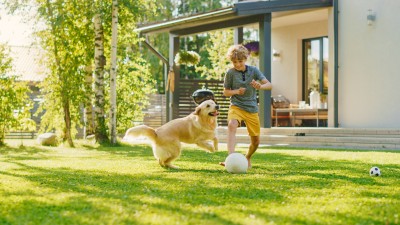Our 5 Favorite Pet-Friendly Backyard & Landscape Ideas

Your backyard should be a fun and functional space for every member of your household, including the furry, four-legged ones. When you’re planning your backyard landscaping, from your grass to your garden, don’t forget that not every option will play well with the family pet.
Getting Started with Your Pet-Friendly Backyard
What do you need to consider your pet when designing your backyard? Here are some key factors to keep in mind.
Some Plants are Toxic for Pets
You’d be surprised at some of the common plants that are poisonous for animals, such as azaleas and lilies. Certain gardening products should also be avoided: snail bait, cocoa mulch, chemical fertilizers, and pesticides, to name a few.
Gorgeous Lawns and Pet Urine Don’t Mix
A backyard is a place to relax, unwind, and have fun. And for your pets, it’s also a place where they, ahem, find “relief” in other ways. This can lead to unsightly yellowing and burnt-looking patches in an otherwise emerald field of grass.
Create a Space to Thrive
Certain breeds of dogs love to dig and can lay waste to your carefully tended landscaping in a matter of minutes. You can prevent this destruction and find ways to keep your pet occupied with a little bit of forethought and planning.
Your backyard oasis should be fun for everyone, including your pets. There are lots of fun and engaging elements you can add to your backyard that will enrich your pet’s life.
So now that we’ve covered why your pet’s needs and nature should be top of mind when deciding on your backyard setup and landscaping, let’s look at some of our favorite pet-friendly ways to make the most of your outdoor space.
1. Add Walkways Your Pets Can Follow
Your dog is going to beat a path in your backyard no matter what you do. This is especially true if your property is fenced and borders on an area where other people or animals regularly pass by. Because dogs are naturally protective of their space, they will “patrol” the area right next to the fence, putting visible wear and tear on the lawn or plants that grow there.
Don’t try to train your dog out of this behavior—it’s a losing battle. Instead, put in a walkway of stones or bricks along the dog path, if your dog has already etched one into the landscape. This is a win-win, as your dog gets its space and the pathway lends a unique charm and aesthetic to your backyard.
“Hardscape” materials like this are also easier on your pet’s paws, keeping them clean and clear of mud and dirt. Just be sure to keep them shaded with plants or other materials since stones, bricks, and concrete can get very hot with the sun beating down directly on them.
2. Plant a Pet-Friendly Garden
It’s important to familiarize yourself with the plants and products that are a no-go in pet-friendly backyards before letting your beloved family dog out to explore.
Here is just a short list of some of the most common plants that are toxic for dogs:
- Aloe vera
- Azaleas
- Begonias
- Bleeding hearts
- Chrysanthemum
- Clematis
- Foxglove
- Iris
- Lily of the valley
- Morning glory
- Tulips
- Wisteria
Herbicides, pesticides, and other chemicals are also potentially harmful to your pet, so be sure to read the packaging carefully before purchasing and using these additives in your backyard. When in doubt, consult an expert on pet-safe plants and gardening practices.
3. Create a Designated Pet “Rest Area”
There are a couple of strategies you can use when dealing with the issue of “dog spots” caused by the nitrogen and salts in your pet’s urine.
One is to simply train your dog to relieve itself in one specific area of your backyard only, preferably an area that has stone, gravel, or dirt instead of grass.
Another is to plant a clover lawn instead of a traditional grass lawn. Clover doesn’t react to dog urine the way that grass does, providing a natural camouflage of your dog’s favorite spots.
If you don’t wish to either restrict your dog’s choice of toilet space or give up your preferred grass type, you also have the option of simply washing away your dog’s urine with water.
This does require some vigilance on your part, but if you can manage to grab the garden hose after every time your dog takes a bathroom break, you can dilute and wash away the damaging compounds so your grass stays healthy and green. The same goes for if you have artificial turf installed in your backyard.
4. Protect Your Plants with Fencing
Another way that dogs can unintentionally interfere with your backyard landscaping is through their other instinctive dog behaviors—namely, running and digging.
Your fragile plants are no match for your dog’s paws, which is why a fence is something you should consider. After all, you don’t want all the time and money you invested in your landscaping to be compromised by an excitable pooch.
You can either build a fence around your garden to protect your plants (which creates a rather charming effect reminiscent of a courtyard or English garden) or you can fence off a designated play area for your dog.
If your dog has a habit of digging holes, you may also want to think about building them a dedicated cooling pit within their fenced off area. This is because lots of dogs who dig compulsively are actually just trying to cool themselves off by getting at the cooler soil that’s located under the surface of your lawn.
By building a pit and filling it with a cool, damp material like sand, you give them a much-needed respite area that they will gravitate to (and leave your lawn alone).
5. Make Your Backyard an Oasis for Your Pet
A cooling pit is just one way to make your backyard more hospitable to your pet, and we recommend adding a few other features that will delight your canine companion.
A doggie splash pool is an easy way to provide a refreshing oasis for your dog from the summer heat. A simple kiddie pool will do, as long as it’s of the sturdy plastic variety, since inflatable pools are just one claw puncture away from total destruction.
When selecting a pool for your dog, take note of the height of the sides, since they should be low enough for your dog to comfortably step over. Small dogs in particular can struggle with slippery plastic surfaces so take care to choose a pool that’s appropriate for your dog’s size and agility.
You can also “adjust” the height of the pool (and make it more discreet) by setting it into the ground, just as a real swimming pool is. All you have to do is dig a shallow area for the kiddie pool to fit into, with about an inch or so of rim space poking up above the surface of the soil.
This way, your dog can get in and out easily, no matter how much or how little leg length they’re working with. Plus, there’s no chance of them trying to grab the pool in their mouth and run off with it when it’s empty (big dogs seem to have a penchant for doing this).
If you don’t have the space for a full-fledged doggie splash pool in your backyard, there are other ways to keep your dog cool, like with a bird-bath-turned fountain or a sprinkler. Non-water-based options include shade clothes and small gazebos that provide shelter and shade from the hot sun.
Shop Pet-Friendly Backyard and Landscape Supplies in Ontario Today
Did this article inspire you to start imagining the possibilities for your own backyard? Get started building your own outdoor oasis with the help of the experts at Legends Landscape Supply.
Our dedicated team of experienced and knowledgeable professionals are here to help with everything from selecting the right materials and products to putting you in touch with local landscapers to design your ultimate backyard.
If you’re a DIY-er, we offer a landscape coaching service that will set you up with the guidance you need for a successful project.


 LANDSCAPE PROFESSIONALS
LANDSCAPE PROFESSIONALS